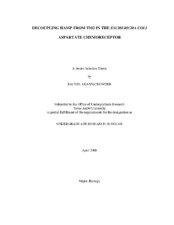| dc.description.abstract | The HAMP (often found in Histidine kinases, Adenylate cyclases, Methyl-accepting
chemotaxis proteins, and Phosphatases) domain is a widely conserved motif often found
in transmembrane signaling proteins in many prokaryotes and lower eukaryotes. It
consists of a pair of two amphipathic helices connected by a flexible linker. Recently,
the solution structure of the Archeoglobus fulgidis Af1503 HAMP domain was isolated
and resolved using NMR. The Af1503 HAMP domain forms a stable four helix bundle
with parallel helices that pack into a non-canonical knob-on-knob conformation. Several
models have been proposed in methyl-accepting chemotaxis proteins (MCPs) to explain
how the four-helix bundle transmits the downward piston movement of transmembrane 2
(TM2) into the signaling domain, inhibiting kinase activity. It is likely the connector
between TM2 and the HAMP domain is important in transducing the input signal from
TM2 to HAMP. Following this rationale, increasing the flexibility of the connector
should reduce the intensity of the output signal. To test the effect of increasing the
flexibility of the TM2/HAMP linker, residues methionine 215 through threonine 218 of
iv
the Escherichia coli aspartate chemoreceptor Tar were replaced with four glycine
residues. Glycine residues were then deleted (-1G through -4G) and added (+1G
through +5G). Aspartate sensitivity, rotational bias, mean reversal frequency, and in
vivo methylation levels were measured. These experiments suggest that increasing the
flexibility between TM2 and HAMP reduces the strength of signal transmission from
TM2 to HAMP, and places the receptor in an inactive form that mimics the attractantbound
state. | en |


